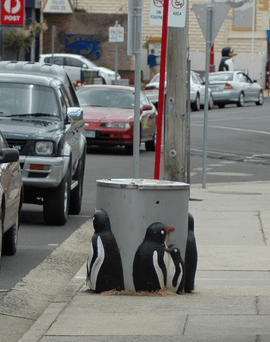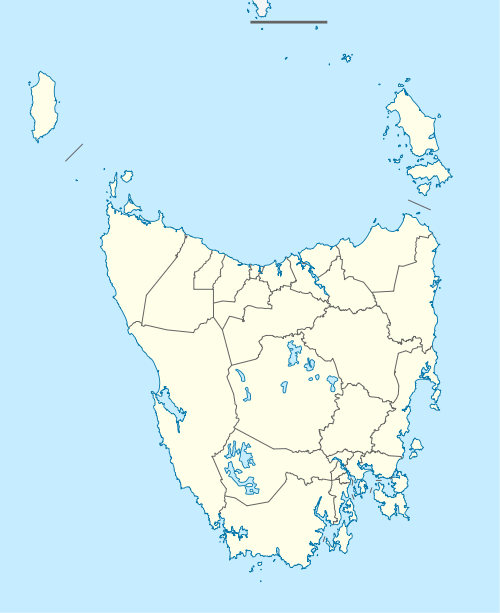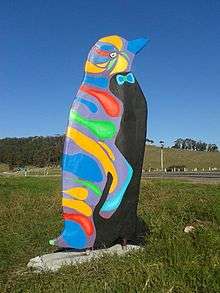Penguin, Tasmania
Penguin is a town on the north-west coast of Tasmania, Australia. It is in the Central Coast Council local government area and on the Bass Highway, between Burnie and Ulverstone. At the 2016 census, Penguin had a population of 3,849.[1]
| Penguin Tasmania | |
|---|---|
 Penguin-themed rubbish bin in the town | |
 Penguin | |
| Coordinates | 41°7′0″S 146°4′15″E |
| Population | 3,849 (2016 census)[1] |
| Established | 1861 |
| Postcode(s) | 7316 |
| Location |
|
| LGA(s) | Central Coast Council |
| State electorate(s) | Braddon |
| Federal Division(s) | Braddon |
History
Penguin was first settled in 1861 as a timber town, and proclaimed on 25 October 1875. The area's dense bushland and easy access to the sea led to Penguin becoming a significant port town, with large quantities of timber shipped across Bass Strait to Victoria, where the 1850s gold rushes were taking place. The town was named by the botanist Ronald Campbell Gunn for the little penguin rookeries that are common along the less populated areas of the coast.[2]
Sulphur Creek Post Office opened on 1 January 1867 and was replaced by the Penguin Creek office in 1868. The latter office was renamed Penguin in 1895.[3]
Penguin was one of the last districts settled along the North West coast of Tasmania, possibly because of an absence of a river for safe anchorage. Nearly all travel in those days was by boat as bush made the land almost impenetrable. Many of the settlers probably emigrated from Liverpool via landing in Launceston then sailing west along the coast.[4] Trade began when the wharf was built in 1870, allowing timber and potatoes to be exported. Penguin Silver Mine, along the foreshore slightly to the east of the town opened in 1870 but failed a year later. Neptune Mine, a tad further along, likewise failed.[5] The rail from Ulverstone arrived in 1901, after which trade by sea declined. Passing of the Local Government Act in 1906 saw Tasmania divided into 48 Municipalities.
Penguin’s first Council was elected in 1907,[6] and the early stages of the municipal council were seen as benefiting the community.[7] It was not until 1993 that the council was amalgamated with the Ulverstone council to form the Central Coast Council (Tasmania).
Aboriginal history of the area
Approximately 12,000 years ago the peninsula/island of Tasmania was separated from mainland Australia. By European arrival in 1803 some 4,000-5,000 semi-nomadic Aboriginal people continued to manage this diverse and changing landscape, both responding to and manipulating the environment.[8]
There were approximately 48 groups contained within nine socio-linguistic cohorts throughout Tasmania, speaking at least 4 distinct languages. The Northern people comprised 3 or possibly 4 groups, totaling 200-300 people. Their lands extended along the coast from Port Sorell to Penguin, inland to the SE corner of the Surrey Hills then East to the base of the Great Western Tiers near Quamby Bluff before turning north to the coast. Each winter the Northern people abandoned the cold of the Western Tiers and the flooded flats of the Meander Valley and traveled to the coast where they would congregate at sites such as Port Sorell at Panatana. The Northern people also had access to some of the most important ochre deposits in Tasmania. Excavations undertaken during the 1980s at the Gog Range mine, now called Toolumbunner, dated activity at this particular mine site back to the 15th century.[8]
Colonisation of the North and Nort West of Van Diemen’s Land was a particularly violent process - far away from the scrutiny of the colonial administration in Hobart. Thirty-two significant incidents of violence have been identified between 1826 and 1834, mostly taking place in the 1827/8 period. Twenty-eight people are known to have been captured by Colonial Authorities while eight were kidnapped by sealers. By 1847, when the 47 surviving Aborigines were transferred from Flinders Island to Oyster Cove, there were no Northern people left alive.[8]
Recent history
The most notable episode, this century, in Penguin’s ongoing evolution was the attempt by property developers, from 2005 to 2008, to purchase properties along the CBD beachfront on Main St with the aim of transforming them into four-storey commercial/residential opportunities. Support for development was mixed, which resulted, eventually, in the developers foregoing all interest in the seaside town.[9][10][11] One manoeuvre to circumvent development involved heritage-listing as much of the CBD as possible.[12] Currently, Penguin has 26 heritage-listed sites.[13]
Education
The Penguin district has two public schools; a kindergarten to year 10 school - Penguin District School and Riana Primary School. Penguin also has one of only two Seventh-day Adventist schools in Tasmania, called the North West Christian School.[14]
Attractions
The Big Penguin, which Penguin is home to, was made of ferro cement by the Goliath Cement Co of Railton and later coated with fiberglass, is located in the town’s centre opposite the Post Office and is the town’s most photographed icon. Unveiled on 25 October 1975, it was erected to commemorate the centenary of the naming of the town.[15] Concerns were raised in 2008 as to the possibility of asbestos contamination, but the Big Penguin was given the all clear.[16] Mount Montgomery is also in the Penguin area. It is also interesting to note that all street rubbish bins are decorated with ornamental cement fairy penguins.
Penguin General Cemetery, with its stunning sunrise views over Bass Strait, is located a kilometre west of the Post Office. Opened in the 1860s, it closed in 1977 and was heritage-listed in 2007.
The response to the cemetery's ongoing and widespread publicity was such that the Tasmanian Association for Hospice & Palliative Care (TAH&PC) funded the inaugural Penguin Twilight Celebration of the Dead - music among the tombstones.[17][18][19] The event, held in the cemetery on 7 January 2015, was supported by the broader Penguin community. It marked the centenary of the cemetery's unknown burial. The one-hour musical extravaganza, involving pipers, vocalists, choir, violinist, flautist and guitarist had the crowd of 120-150 people meandering around six of the more significant tombstones. The celebration culminated in a butterfly release in the commemorative garden dedicated to the tens of unnamed babies in the cemetery.[20][21][22][23] A fund-raising onsite formal long-table dinner was held in February 2016.
In 2018 Penguin launched its heritage sites and other attractions website.[24] Most recently the Penguin community dedicated a sculpture to its many unnamed children buried in the cemetery.[25] Children of the World by Bruny Island artist Keith Smith stands in its small commemorative garden.[26]
October 2018 saw all shops in the CBD decked out in Pink thanks to local Shirly Good. Pink Up Your Town is a fundraising activity for the McGrath Foundation.[27] It also saw the community coming together to revitalise the foreshore under the 7-Day Makeover program.[28]
Currently under construction is a unique artwork, a front mosaic and back word jumble, celebrating how marginalised people contribute to our communities, despite their struggles. It demonstrates how a sense of community can develop around marginalised people, by highlighting words that we can all identify with through our lived experiences of good and bad days – or, life.[29]

Notable residents
- Wolfgang Grasse, an internationally renowned painter, of German origin, who'se art addresses the horrors of war as he was a first hand witness to the Dresden Bombings as a young teenager, and later spent several years in a Polish gulag as an enemy of the Russian state. The artist is presented by Stephen Romano Gallery in New York[30]
- Amy Cure, a world champion track cyclist; winner of the 2014 Women's 25 km Points race in Cali, Colombia[31]
- Alannah Hill, fashion designer, lived in Penguin during her childhood (1960s?-1979), as her parents owned a milk bar in the town[32]
- Trevor Kaine, the second Chief Minister of the Australian Capital Territory, 1989–91, was born in Penguin in 1928
- Alister Nicholson, sports commentator for ABC Grandstand, covered events such as 2014 Commonwealth Games, 2016 Olympic Games and regular AFL and international cricket
- Grant O’Brien, Former CEO of Woolworths (2011-2015) and professional Australian Rules Footballer for Glenelg FC
- Russell Robertson, an Australian rules footballer for the Melbourne Demons, attended Penguin High School from 1991 to 1994
- Samora Squid, a professional contortionist born with an acute case of Joint Hypermobility Syndrome[33]
- John Wilton, member for Broadmeadows in the Victorian Legislative Assembly from 1962 to 1985, was born in Penguin in 1925
Gallery
| Wikimedia Commons has media related to Penguin, Tasmania. |
 Pablo the penguin, just one of the many colourful penguins in, and about, Penguin
Pablo the penguin, just one of the many colourful penguins in, and about, Penguin Penguin Big Penguin
Penguin Big Penguin Penguin General Cemetery's interpretive signage
Penguin General Cemetery's interpretive signage Children of the World sculpture
Children of the World sculpture Uniting Church in Penguin
Uniting Church in Penguin
References
- Australian Bureau of Statistics (27 June 2017). "Penguin (State Suburb)". 2016 Census QuickStats. Retrieved 22 July 2017.

- Travel: Penguin, The Age, February 8, 2004.
- Premier Postal History. "Post Office List". Premier Postal Auctions. Retrieved 16 June 2012.
- Barker, Arthur (1956). Penguin's Pioneering Days. Penguin Advocate. State Library of Tasmania. p. 3.
- Alexander, Alison (2005). The companion to Tasmanian History. State Library of Tasmania: Centre for Tasmanian Historical Studies, University of Tasmania, Hobart. p. 269.
- Barker, Arthur (1956). Penguin's Pioneering Days. Penguin Advocate. State Library of Tasmania. p. 10.
- "PENGUIN". The North Western Advocate And The Emu Bay Times. Tasmania, Australia. 7 January 1909. p. 2. Retrieved 13 December 2018 – via National Library of Australia.
- McFarlane, Ian (2008). Beyond awakening: The Aboriginal tribes of northwest Tasmania: A history. State Library of Tasmania: Place & Heritage Research Unit, University of Tasmania, Hobart. pp. 1–302.
- Craig, Natalie. "No-room-for-gay-developer-in-penguins-property-parade". The Age. Retrieved 26 September 2013.
- "Gay-tycoon-flees-hostile-penguin". Metro. Retrieved 26 September 2013.
- Pippos, Chris. "Property sell off won't cover Roche debt". The Advocate. Retrieved 26 September 2013.
- "Council to fork out for heritage fight". The Advocate. Retrieved 12 July 2013.
- "Tasmanian Heritage Register" (PDF). Heritage Tasmania. Archived from the original (PDF) on 12 December 2013. Retrieved 26 September 2013.
- http://northwestchristianschool.com.au/about/
- Haberle, Carol. "Big Penguin, Church, Market, Railway…". Think-Tasmania.com. Retrieved 26 September 2013.
- "Big Penguin passes asbestos test". ABC News. Retrieved 26 September 2013.
- "Penguin's celebration of the dead". ABC National Radio. Archived from the original on 29 November 2014. Retrieved 20 November 2014.
- "Penguin's twilight celebration of the dead" (PDF). Central Coast Tourism News & Events Newsletter. Archived from the original (PDF) on 6 January 2015. Retrieved 1 December 2014.
- Lamont, Damita. "Music pays tribute to cemetery's unknown". The Advocate. Retrieved 6 January 2015.
- Wilson, Stuart. "Music-among-the-tombstones-pictures-photos". The Advocate. Retrieved 8 January 2015.
- Woods, Emily. "Penguin-cemetery-event-celebrates-life-with-music". The Advocate. Retrieved 8 January 2015.
- Eaves, Rick. "Penguin's Twilight Celebration of the Dead breaks new cultural ground in a heritage-listed cemetery". ABC Northern Tasmania. Retrieved 12 January 2015.
- "Penguin General Cemetery". Southern Cross News Tasmania. Retrieved 18 January 2015.
- Lansdown, Sarah. "Explore-Penguin's-history-with-the-heritage-trail". The Advocate. Retrieved 23 April 2018.
- Eaves, Rick. "Penguin Cemetery something of a social hub". ABC Northern Tasmania. Retrieved 12 September 2018.
- Lansdown, Sarah. "Penguin's tribute to children stands tall". The Advocate. Retrieved 12 September 2018.
- Morris, Rebecca. "Painting the town pink for breast cancer awareness month". The Advocate. Retrieved 10 October 2018.
- Lansdown, Sarah. "Penguin enjoys a quirky makeover". The Advocate. Retrieved 1 November 2018.
- Wirsu, Piia. "Penguin's mental health mosaic & word jumble public art". ABC Northern Tasmania. Retrieved 29 November 2019.
- Wolfgang Grasse at Stephen Romano Gallery, New York].
- 2014 UCI Track Cycling World Championships – Women's points race
- Significant Women: Alannah Hill, Government of Tasmania.
- https://www.samorasquid.com/home.html